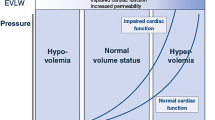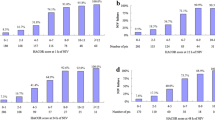Abstract
The authors tested the hypothesis that in the high-altitude acclimatized fetus, hypercapnia has a significantly less effect on cerebral blood flow (CBF) and cerebral oxygenation than that in normoxic sea level controls. In the high-altitude acclimatized fetus (3801 m; maintained from day 30 of gestation to near term; n = 6), by use of a laser Doppler flowmeter with a fluorescent O2 probe, the authors measured relative CBF (laser Doppler CBF [LD-CBF]), cortical tissue PO2 (tPO2), and sagittal sinus oxyhemoglobin saturation (HbO2) in response to 20-minute hypercapnia. They also calculated cerebral O2 delivery and cerebral fractional O2 extraction. The authors compared these results to those obtained in near-sea-level control animals (low-altitude group). In response to hypercapnia (arterial PCO2 = 63 ± 2 torr vs 42 ± 1 torr baseline), high-altitude fetuses showed similar increases in LD-CBF, cortical tPO2, and sagittal sinus (HbO2) as compared with those responses seen in the fetus at low altitude. Nonetheless, these fetuses showed a significantly smaller decrease in cerebral fractional O2 extraction compared to low-altitude fetuses. In response to hypercapnia in high-altitude, acclimatized, long-term hypoxic fetal sheep, the response of CBF and cerebral oxygenation did not differ significantly from that of low-altitude controls.
Similar content being viewed by others
References
Moore LG, Niermeyer S, Zamudio S. Human adaptation to high altitude and life-cycle perspective. Am J Phys Anthropol. 1998;(suppl 27):5–64.
Litchy JL, Ting R, Bruns PD, Dyar E. Studies of babies born at high altitude. Am J Dis Child. 1957;93:666–669.
McCullough RE, Reeves JT, Liljegren RL. Fetal growth retardation and increased infant mortality at high altitude. Arch Environ Health. 1977;32:36–40.
Jensen GM, Moore LG. The effect of high altitude and other risk factors on birth weights: independent or interactive effects? Am J Public Health. 1997;87:1003–1007.
Giussani DA, Phillips PS, Anstee S, Barker DJ. Effects of altitude versus economic status on birth weight and body shape at birth. Pediatr Res. 2001;49:490–494.
Sobrevilla LA, Cassinelli MT, Carcelen A, Malaga JM. Human fetal and maternal oxygen tension and acid-base status during delivery at high altitude. Am J Obstet Gynecol. 1971;111: 1111–1118.
Kamitomo M, Longo LD, Gilbert RD. Right and left ventricular function in fetal sheep exposed to long-term high-altitude hypoxemia. Am J Physiol. 1992;Suppl 27:25–64.
Ballew C, Haas JD. Hematologic evidence of fetal hypoxia among newborn infants at high altitude in Bolivia. Am J Obstet Gynecol. 1986;155:166–169.
Longo LD, Pearce WJ. Fetal cerebrovascular acclimatization responses to high-altitude, long-term hypoxia: a model for prenatal programming of adult disease? Am J Physiol Regul Integr Comp Physiol. 2005;288:R16–R24.
Tomimatsu T, Pereyra-Peňa J, Hatran DP, Longo LD. Maternal oxygen administration and fetal cerebral oxygenation: studies on near-term fetal lambs at both low and high altitude. Am J Obstet Gynecol. 2006;195:535–541.
Bureau MA, Shapcott D, Berthiaume Y, et al. Maternal cigarette smoking and fetal oxygen transport: a study of P50, 2,3-diphosphoglycerate, total hemoglobin, hematocrit, and type F hemoglobin in fetal blood. Pediatrics. 1983;72:22–26.
Habek D, Habek JC, Ivanisevic M, Djelmis J. Fetal tobacco syndrome and perinatal outcome. Fetal Diagn Ther. 2002;17:67–71.
Socol ML, Manning FA, Murata Y, Druzin ML. Maternal smoking causes hypoxia: experimental evidence. Am J Obstet Gynecol. 1982;142:214–218.
Cannell DE, Vernon CP. Congenital heart disease and pregnancy. Am J Obstet Gynecol. 1963;85:744–753.
De Swiet M. Respiratory disease in pregnancy. Postgrad Ned J. 1979;55:325–328.
Bernstein IM, Horbar JD, Badger GJ, Ohlsson A, Golan A. Morbidity and mortality among very-low-birth-weight neonates with intrauterine growth restriction. The Vermont Oxford Network. Am J Obstet Gynecol. 2000;182:198–206.
Jelliffe-Pawlowski LL, Hansen RL. Neurodevelopmental outcome at 8 months and 4 years among infants born full-term small-for-gestational-age. J Perinatol. 2004;24:505–514.
Jones MD Jr, Traystman R. Cerebral oxygenation of the fetus, newborn, and adult. Semin Perinatol. 1984;8:205–216.
Madden JA.The effect of carbon dioxide on cerebral arteries. Pharmacol Ther. 1993;59:229–250.
Tomimatsu T, Pereyra Peňa J, Longo LD. Fetal hypercapnia and cerebral tissue oxygenation: studies in near-term sheep. Pediatr Res. 2006;60:711–716.
Long W, Zhang L, Longo LD. Fetal and adult cerebral artery K(ATP) and K(Ca) channel responses to long-term hypoxia. J Appl Physiol. 2002;92:1692–1701.
Longo LD, Hull AD, Long DM, Pearce WJ. Cerebrovascular adaptations to high-altitude hypoxemia in fetal and adult sheep. Am J Physiol. 1993;264(1 pt 2): R65–R72.
Lotgering FK, Gilbert RD, Longo LD. Exercise responses in pregnant sheep: blood gases, temperatures, and fetal cardiovascular system. J Appl Physiol. 1983;55:842–850.
Xu K, Lamanna JC. Chronic hypoxia and the cerebral circulation. J Appl Physiol. 2006;100:725–730.
Moller K, Paulson OB, Hornbein TF, et al. Unchanged cerebral blood flow and oxidative metabolism after acclimatization to high altitude. J Cereb Blood Flow Metab. 2002;22: 118–126.
Kamitomo M, Alonso JG, Okai T, Longo LD, Gilbert RD. Effects of long-term, high-altitude hypoxemia on ovine fetal cardiac output and blood flow distribution. Am J Obstet Gynecol. 1993;169:701–707.
Krampl E, Lees C, Bland JM, Espinoza Dorado J, Moscoso G, Campbell S. Fetal Doppler velocimetry at high altitude. Ultrasound Obstet Gynecol. 2001;18:329–334.
Jones MD Jr, Rosenberg AA, Simmons MA, Molteni RA, Koehler RC, Traystman RJ. Oxygen delivery to the brain before and after birth. Science. 1982;216:324–325.
Mallard EC, Rehn A, Rees S, Tolcos M, Copolov D. Ventriculomegaly and reduced hippocampal volume following intrauterine growth-restriction: implications for the aetiology of schizophrenia. Schizophr Res. 1999;40:11–21.
Mallard EC, Rees S, Stringer M, Cock ML, Harding R. Effects of chronic placental insufficiency on brain development in fetal sheep. Pediatr Res. 1998;43:262–270.
Rees S, Inder T. Fetal and neonatal origins of altered brain development. Early Hum Dev. 2005;81:753–761.
Penninga L, Longo LD. Ovine placentome morphology: effect of high altitude, long-term hypoxia. Placenta. 1998;19:187–193.
Krampl E, Lees C, Bland JM, Espinoza Dorado J, Moscoso G, Campbell S. Fetal biometry at 4300 m compared to sea level in Peru. Ultrasound Obstet Gynecol. 2000;16:9–18.
LaManna JC, Vendel LM, Farrell RM. Brain adaptation to chronic hypobaric hypoxia in rats. J Appl Physiol. 1992;72: 2238–2243.
Norcliffe LJ, Rivera-Ch M, Claydon VE, et al. Cerebrovascular responses to hypoxia and hypocapnia in high-altitude dwellers. J Physiol. 2005;566:287–294.
Cunningham FG, Lenko KJ, Bloom SH, Hauth JC, Gilstrap L III, Wenstrom KD, eds. The newborn infant. In: Williams Obstetrics. 22nd ed. New York, NY: McGraw-Hill; 2005:641–641.
Gregg AR, Weiner CP. “Normal” umbilical arterial and venous acid-base and blood gas values. Clin Obstet Gynecol. 1993;36:24–32.
Pereyra Peña JL, Tomimatsu T, Hatran DP, McGill LL, Longo LD. Cerebral blood flow and oxygenation in the ovine fetus: responses to superimposed hypoxia at both low and high altitude. J. Physiol. (Lond.) 578.1:359–370, 2007.
Author information
Authors and Affiliations
Corresponding author
Additional information
Supported by US Public Health Service grants HD/HL-03807 and HD- 31226 to Lawrence D. Longo.
We thank Larkin Rieke, Douglas P. Hatran, and Shannon Bragg for technical assistance and Brenda Kreutzer for preparing the manuscript.
Rights and permissions
About this article
Cite this article
Tomimatsu, T., Peňa, J.P. & Longo, L.D. Fetal Hypercapnia in High-Altitude Acclimatized Sheep: Cerebral Blood Flow and Cerebral Oxygenation. Reprod. Sci. 14, 51–58 (2007). https://doi.org/10.1177/1933719106298211
Published:
Issue Date:
DOI: https://doi.org/10.1177/1933719106298211




